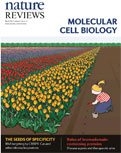|
Advertisement | |||||||||||||||||||||||||||||||||||||||||||||||
| |||||||||||||||||||||||||||||||||||||||||||||||
| TABLE OF CONTENTS | |||||||||||||||||||||||||||||||||||||||||||||||
| April 2017 Volume 18 Number 4 | |||||||||||||||||||||||||||||||||||||||||||||||
2015 2-year Impact Factor 38.602 Journal Metrics 2-year Median 30 | In this issue
| ||||||||||||||||||||||||||||||||||||||||||||||
| |||||||||||||||||||||||||||||||||||||||||||||||
 | |||||||||||||||||||||||||||||||||||||||||||||||
| Advertisement | |||||||||||||||||||||||||||||||||||||||||||||||
| |||||||||||||||||||||||||||||||||||||||||||||||
| Advertisement | |||||||||||||||||||||||||||||||||||||||||||||||
| |||||||||||||||||||||||||||||||||||||||||||||||
| Advertisement | |||||||||||||||||||||||||||||||||||||||||||||||
| |||||||||||||||||||||||||||||||||||||||||||||||
| |||||||||||||||||||||||||||||||||||||||||||||||
| Advertisement | |||||||||||||||||||||||||||||||||||||||||||||||
| |||||||||||||||||||||||||||||||||||||||||||||||
| REVIEWS | Top | ||||||||||||||||||||||||||||||||||||||||||||||
| RNA-based recognition and targeting: sowing the seeds of specificity Stanislaw A. Gorski, Jörg Vogel & Jennifer A. Doudna p215 | doi:10.1038/nrm.2016.174 Insights into eukaryotic, bacterial and archaeal RNA-based regulatory systems, including microRNAs, small interfering RNAs, clustered regularly interspaced short palindromic repeats (CRISPR) RNA and small RNAs that are dependent on the RNA chaperone protein Hfq, have revealed that they achieve specificity using similar strategies. Specifically, the presentation of short 'seed sequences' within a ribonucleoprotein complex facilitates the search for and recognition of targets. Abstract | Full Text | PDF | |||||||||||||||||||||||||||||||||||||||||||||||
| Mechanisms and functions of nuclear envelope remodelling Rosemarie Ungricht & Ulrike Kutay p229 | doi:10.1038/nrm.2016.153 The nuclear envelope is more than a static barrier between the nuclear and cytoplasmic compartments. It is very dynamic and undergoes extensive remodelling in response to mechanical challenges as well as during cell division, growth and differentiation. Abstract | Full Text | PDF | |||||||||||||||||||||||||||||||||||||||||||||||
| Functions of bromodomain-containing proteins and their roles in homeostasis and cancer Takao Fujisawa & Panagis Filippakopoulos p246 | doi:10.1038/nrm.2016.143 Bromodomains (BRDs) are domains found in diverse proteins that recognize acetylated Lys residues, primarily on histones. Hence, BRD-containing proteins serve as readers of protein acetylation and engage in the regulation of gene expression. Recent studies have provided new insights into the physiological roles of BRD-containing proteins and their deregulation in cancer. Abstract | Full Text | PDF | Supplementary information | |||||||||||||||||||||||||||||||||||||||||||||||
| The code and beyond: transcription regulation by the RNA polymerase II carboxy-terminal domain Kevin M. Harlen & L. Stirling Churchman p263 | doi:10.1038/nrm.2017.10 The carboxy-terminal domain (CTD) of RNA polymerase II is a repetitive and unstructured domain that is dynamically modified by post-translational modifications, which collectively constitute the 'CTD code'. Recent studies have revealed how CTD function is also promoted by phase separation in the presence of other low-complexity domains. Abstract | Full Text | PDF | |||||||||||||||||||||||||||||||||||||||||||||||
| |||||||||||||||||||||||||||||||||||||||||||||||
| *2015 Journal Citation Reports (Thomson Reuters, 2016) |
You have been sent this Table of Contents Alert because you have opted in to receive it. You can change or discontinue your e-mail alerts at any time, by modifying your preferences on your nature.com account at: www.nature.com/myaccount For further technical assistance, please contact our registration department For print subscription enquiries, please contact our subscription department For other enquiries, please contact our feedback department Nature Publishing Group | One New York Plaza, Suite 4500 | New York | NY 10004-1562 | USA Nature Publishing Group's worldwide offices: Macmillan Publishers Limited is a company incorporated in England and Wales under company number 785998 and whose registered office is located at The Campus, 4 Crinan Street, London, N1 9XW. © 2017 Nature Publishing Group, a division of Macmillan Publishers Limited. All Rights Reserved. |
 |









No comments:
Post a Comment